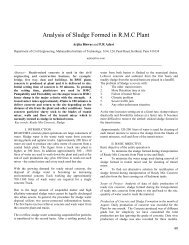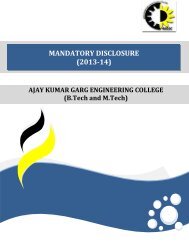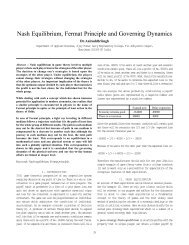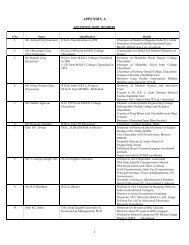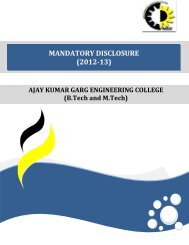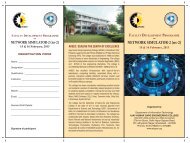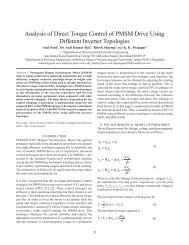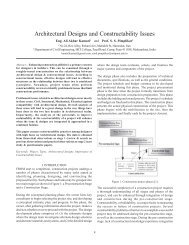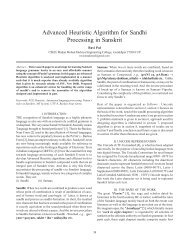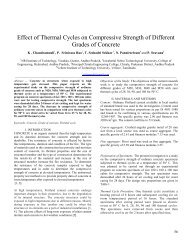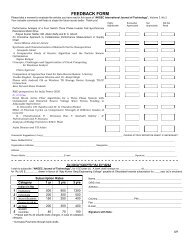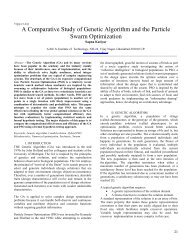Linear Chirp Signal and Exponential Sweep Signal Suppression ...
Linear Chirp Signal and Exponential Sweep Signal Suppression ...
Linear Chirp Signal and Exponential Sweep Signal Suppression ...
Create successful ePaper yourself
Turn your PDF publications into a flip-book with our unique Google optimized e-Paper software.
SIGNAL SUPPRESSION USING VOLTERRA FILTERSWorking of Volterra filter as Broadb<strong>and</strong> Interference ExciserIn Volterra filter, the received sequence of length ‘N’ is exp<strong>and</strong>edby Volterra series into a longer sequence of length ‘M’ suchthat M>N. It is processed with an M tap filter [5].measurement helps us to see if our system model is indeedminimizing the error <strong>and</strong> it is sometimes called the learningcurve of the algorithm [8].Most workers have used the second <strong>and</strong> the third orderVolterra filters that gives fair level of computationalcomplexity. As for the sake of simplicity we are usingsecond order Volterra filter [9].Adaptive second order Volterra filterVolterra series expansion of second order, is described bythe truncated version of equation (1).Figure 1. A Block Diagram of Adaptive Volterra Filter.As shown in Figure 1, the system consists of twochannels. The first channel is used to transmit the desiredinput signal s(n). However due to a noisy environment, thesignal is contaminated <strong>and</strong> the channel produces a signalwith the interference that is broadb<strong>and</strong> in our case, sod(n) = s(n)+n(n). The second channel is left vacant <strong>and</strong> noinput signal is given to it so it only captures interferencex(n), which is fed to the Volterra filter. Note that thecorrupting interference n(n) in the first channel isuncorrelated to the desired signal d(n), so that separationbetween them is possible. The interference signal x(n) fromthe second channel is correlated to the corruptinginterference signal n(n) in the first channel, since bothcome from the same noise source. Similarly, the interferencesignal x(n) is not correlated to the desired speech signald(n). We assume that the corrupting interference in the firstchannel is linear filtered version of the second-channelinterference, since it has a different physical path from thesecond-channel interference, <strong>and</strong> the interference source istime-varying, so that we can estimate the corrupting signaln(n) using an adaptive Volterra filter.The Volterra filter is actually a digital filter with adjustablecoefficients <strong>and</strong> the LMS or RLS algorithm modifies thevalues of the coefficients for filtering each sample. TheVolterra filter then produces an estimate of interferencey(n), which will be subtracted from the corrupted signald(n) = s(n)+n(n). When the noise estimate y(n) equals orapproximates the noise n(n) in the corrupted signal, that is,y(n) ≈ n(n), the error signal e(n) = s(n)+n(n)-y(n) ≈ s(n) willapproximate the clean input signal s(n). Hence, theinterference is suppressed. Aim of the filter is to producey(n) very close to d(n) or minimize e(n) such that theinterference is suppressed as it reaches to the receiver [7].According to the above idea the following performancemeasure used in Volterra filter is defined by Mean SquareError (MSE). The MSE is a measure of how the algorithmconverges to the true value in a mean square sense & thiswhere w 0i(l 1,l 2) for i= 0, 1, . . . ,N, are the coefficients ofthe nonlinear filter model based on the second-orderVolterra series expansion, <strong>and</strong> Y(n) represents the adaptivefilter output signal [6]. Now, the input signal X(n) isinterpreted in the following wayX(n) = [ x(n) x(n-1) — x(n-N) x 2 (n) x(n)x(n-1)— x(n)x(n-N) x(n-N)x(n-N+1) x 2 (n-N)]The filter coefficients are interpreted in the following wayW(n)= [w o(n) w 1(n) — w N(n) w 0,0(n) w 0,1(n) — w 0,N(n)— w N,N-1(n) w N,N(n)]So, the output, Y(n) is as follows:Y(n) = W T (n)X(n)Volterra kernels estimation by the LMS (least meansquare) adaptive algorithm:The well-known LMS algorithm is a sample basedalgorithm, which does not require collection of data <strong>and</strong>does not involve matrix inversion.Though the LMS algorithm has its weakness such as itsdependence on signal statistics, which can lead to lowspeed or residual errors, it is very simple to implement <strong>and</strong>well behaved compared to the faster recursive algorithms.The Volterra filter input <strong>and</strong> output can be compactlyrewritten asY(n) = W T (n)X(n)where, X(n) <strong>and</strong> W(n) are N most recent inputs <strong>and</strong> theirnonlinear combinations into one exp<strong>and</strong>ed input vector <strong>and</strong>exp<strong>and</strong>ed filter coefficients vector respectively.The error signal e(n) is formed by subtracting Y(n) fromthe noisy response d(n)e(n) = d(n)-Y(n)19



